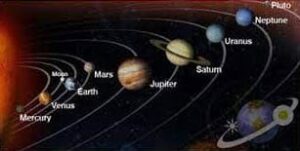The Role of Heavenly Bodies in Agriculture
The Role of Heavenly Bodies in Agriculture
The Role of Heavenly Bodies in Agriculture
Seventy percent of the world’s population is involved, either directly or indirectly in agriculture as agriculture is the root of all food and things which are necessary for the survival of mankind. But the matter of regret is that the people who are involved in agriculture are mostly illiterate. They can hardly read and write. Even though they are far away from being familiar with the use of modern scientific technology. And more to say, that the scientific research on agriculture got less and late importance. But after the half of the twentieth century, the science and technology of agriculture have been showing rapid progress. Yet still today the scientific technology and scientific outlook have not reached most peasants and farmers living in under-developed and developing countries. They have been cultivating land with traditional hand-made tools. But it is a matter of wonder that the cultivators have some beliefs and customs handed down from generation. They have been running their agricultural activities following their traditional beliefs and rules. We see that our grandfathers, though they were mostly illiterate have some knowledge of climate, weather, seasons and other natural phenomena. They sow seeds; apply manure, plough lands and harvest crops noticing the ascending and descending rhythms of the moon. Only some years back, while we were students and even the most educated people laughed at their customs and beliefs and said that their beliefs and customs were blind faiths.
But, of late, research scholars have found out that some of the traditional beliefs of the illiterate peasants have scientific significance. After constant research, modern science has come to know that the sun, planets, moon and other heavenly bodies interact among themselves and their impact fall, either directly and indirectly, on the flora and fauna of the earth. Let us, now discuss their impact on agriculture as under.
Scientists have found out that the lights of the Sun, Moon, Planets and Stars reach the earth in regular rhythms. Each contributes to the life, growth and form of plants. The planets affect on rocks, metals, plants, animals and human beings. Thus Sun shine contributes to the growth of plants and Moon affects the water content of all organisms. Along with the Moon, the planets as Mercury and Venus work directly on the flora and fauna of the earth through the atmosphere or indirectly through water, humus or calcium. The influences of Mars, Jupiter and Saturn are channeled through warmth and Silica (quartz, feldspar, mica). They stream in through the Silica contents of soil and on plants being expressed in colours of flowers, in fruit and seed production.
The impact of the zodiac, which is a belt of some fixed stars, is also important. The belt which we call the constellation lies behind the elliptic path of the sun. The planets move in front of these constellations. Owing to the different sizes of the constellations, the Moon happens to be in front of a constellation for a shorter or longer duration. At the time of its passing through the constellations, they engender certain favourable effects on the planet. There are four groups of constellations each of which has the same qualities. They are related to the basic four elements i.e.—earth, water, fire and air. These four elements can be placed in relation to the four parts of the plants i.e. the root, the leaf, the flower, the fruit and the seed. The root is associated with the earth. The leaf is associated with water as it contains 80% of water. The flower corresponds to air and light. The fruit and seed are associated with fire as there is no fruit ripening and seed maturity without optimal warmth. Agricultural activities such as—land preparation, sowing, fertilizing, harvesting etc. if performed as per constellation would be more effective and beneficial. Performing farm operations on specific days means harnessing these cosmic and earthly influences for the development of particular plant parts.
The impact of the Sun is even more considerable. It passes in front of the twelve zodiac constellations during the course of a year. From January to June it passes through Sagittarius to Taurus which makes spring and summer times of the year. This can be as the ascending movement of the sun when the sun’s arc gets higher each day till midsummer. From July to December it passes through Gemini to Capricorn which makes the autumn and winter times of the year. This is the descending movement of the sun as its arc gets lower each day. As the sun ascends there is an outpouring of growth activity above the ground. Growth forces and sap flow upwards more strongly and fill the plants with vitality. It is said that during the ascending period of the sun the earth breathes out. During the descending period of the sun, the growth activity happens below the soil surface. Underground parts of plants i.e. tubers, rhizome corms etc. especially the roots are activated. It is said that during this descending period of the sun the earth breathes in.
The effect of ascending and descending of the Moon is as similar as that of the sun. During the ascending period, we see the following stages of the Moon as—New Moon (Crescent Moon), First Quarter Moon and Gibbous Moon. During the descending period, we notice the following stages as—Full moon—Disseminating: second quarter: Balsamic. During the descending period, the plants of the earth develop leaves above ground and during the descending period of the Moon the plants develop their root under the ground.
During the ascending period of the Moon the cultivators and others who lead on agricultural works should follow the following activities:
(i) They should use medicine or other things if needed to the upper parts i.e. leaves of the plants.
(ii) They should sow seeds.
(iii) They should harvest crops (except root crops).
The descending period is suitable for the following agricultural activities as—
(i) Plant cutting.
(ii) Preparation of compost.
(iii)Transplantation of seedlings.
(iv) Land preparation.
(v) Manure application.
(vi) Harvesting of root crops.
The Moon’s orbit around the earth is elliptic and not a circle. So the distance of the Moon from the Earth changes every day. The point where the Moon is closest to the earth is called Perigee and the point where the Moon is farthest from the earth is called Apogee. In the Perigee the gravitational force of the Moon accelerates soil moisture upwards. Hence, there is more moisture in the upper layer of the earth. In large water bodies, especially in the seas and oceans tides happen. In Apogee, when the Moon is farthest from the cultivators should mind the following activities as—
(i) No agricultural operation.
(ii) Avoid seed sowing except potato.
(iii) Felling trees.
(iv) Seed storage.
In 48 hours, proceeding to the Full Moon there is a distinct increase in the moisture content in the environment. The growth forces of the plants enhance. The Full Moon period is connected with the growing tendency of the plant and the quick germination of seeds. Often there is a tendency for rain at Full Moon. Besides this, the cultivators are made known that during the Full Moon they should avoid harvesting as during these days water content in the air is higher and the corn may contain more water which may not suitable for storage.
These are, as discussed above, the impacts of the heavenly bodies on the plants of the earth which have come out as a result of research works of the scientists of the world. If the cultivators act in accordance with these facts then their production would be more effective and fruitful. 0 0 0.
The Role of Heavenly Bodies in Agriculture
You May Like: Positive Thought, Patience and Perseverance
The Role of Heavenly Bodies in Agriculture
N. B. The article ‘The Role of Heavenly Bodies in Agriculture’ originally belongs to the book ‘Articles on Contemporary Affairs‘ by Menonim Menonimus.
The Role of Heavenly Bodies in Agriculture
Books of Composition by M. Menonimus:
- Advertisement Writing
- Amplification Writing
- Note Making
- Paragraph Writing
- Notice Writing
- Passage Comprehension
- The Art of Poster Writing
- The Art of Letter Writing
- Report Writing
- Story Writing
- Substance Writing
- School Essays Part-I
- School Essays Part-II
- School English Grammar Part-I
- School English Grammar Part-II..
Books on Literary Criticism by M. Menonimus:
- World Short Story Criticism
- World Poetry Criticism
- World Drama Criticism
- World Novel Criticism
- World Essay Criticism
- Indian English Poetry Criticism
- Indian English Poets and Poetry Chief Features
- Emily Dickinson’s Poetry-A Thematic Study
- Walt Whitman’s Poetry-A Thematic Study
- Critical Essays on English Poetry
- Tawfiq al-Hakim’s Novel: Return of the Spirit-An Analytical Study
- Tawfiq al-Hakim’s Novel: ‘Yawmiyyat Naib Fil Arayaf’-An Analytical Study
- Analytical Studies of Some Arabic Short Stories
- A Brief History of Arabic Literature: Pre-Islamic Period (500 AD-622 AD)
- A Brief History of Arabic Literature: Early Islamic Period (622 AD-661 AD) …
Related Search:











